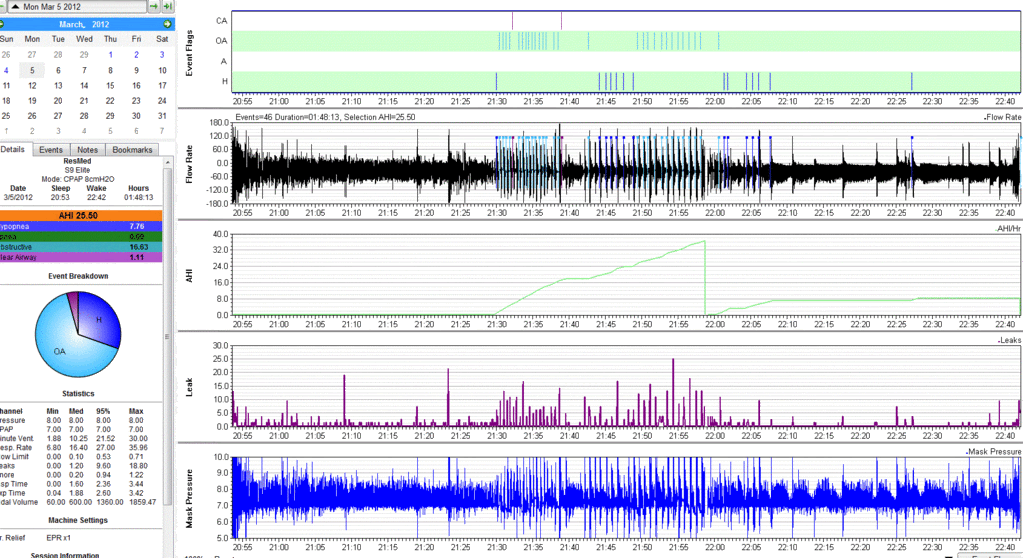BigTex,
Instead of trying to get the DME or doc's office to look at the data, I'd suggest a very different tactic.
Call them back and focus the conversation on the following points in more or less this order:
1) You are feeling MUCH WORSE while sleeping with the mask; indeed you do not feel as though you are getting enough sleep and you know you are taking the mask off at night just so you can get some sleep Point out that your daytime functioning is deteriorating as well.
2) You do not have trouble
falling asleep with the mask on. And when you put the mask on at night, you can't find any leaks. But you ARE having trouble
staying asleep with the mask on. You know you get frustrated after waking up and you are often simply taking the mask off due to the frustration of NOT SLEEPING.
If you can pinpoint what is waking you up, tell them that too: Saying something like:
- "I wake up a couple of hours after going to sleep and when I wake up, I am very uncomfortable due to <fill in the reasons you are so uncomfortable> and because of that I cannot relax enough to get back to sleep until after I take the mask off."
should get their attention.
3) You know you need to make this work and you want to make it work, but that at this point you are VERY WORRIED about the compliance data because you KNOW you are not compliant. But be brutally honest and tell them directly what you've written here:
I am worse off today then before I got the cpap when it comes to lack of sleep. I would love to take a few days off the mask and just get some sleep but that will not work towards compliance.
At this time I am not near to be compliant. I really dont get this. If I dont get this working I will not be compliant and insurance will not pay.
In other words, focus the conversation on the issues of
compliance and
your inability to sleep with the machine since these are the things that the DME and the doc
are interested in: Both the doc and the DME will care when they hear you say that you just cannot seem to get past
two hours of sleep with the mask before you get to the point where you rip it off your face and just return to sleep without it on at all.
So, for now, focus the conversation on getting some help with getting over the hump of compliance---i.e. focus on getting them to understand that you want and need help in figuring out
how to stay asleep with the mask on.
And when the doc or DME mentions that "maybe you are leaking"---that's when to first reiterate that you can find no leaks when you first go to sleep and gently suggest that you wonder if the data on the card might show something about the leaks. (Yes, I'm suggesting acting dumb. Sometimes it works.) Once you trick them into downloading the data in an effort to disabuse you of your "notion" that "leaks aren't the issue", they'll see both the leak data and the over high AHI. And maybe then the doc and the DME will be of more use to you.
And for what it's worth, here's my take on your leak data: If the DME or doc looked at that leak data, they'd likely conclude that leaks are not that big of an issue.
Here's why: The detailed leak line data that you posted stays well below the Resmed Red Line at 24 L/min. The summary data for the 95% leak rate and the median leak rate also indicate that your leaks stay well below the Red Line for 95% of the night and and are trivial for at least 50% of the night. The importance of the Resmed Red Line is this: The Resmed engineers believe the S9 is quite capable of compensating for leaks that are less than 24 L/min without much problem and they are only seriously worried about the impact of leaks greater than or equal to 24 L/min when they last at least 30% of the total night. So your leaks are not likely affecting the
quality of your treatment, which means that the nasty clusters that are leading to AHIs > 20 are not something that can be written off to "bad data because of high leaks."
Now, that's not to say that leaks are not an issue: If the leaks are causing you to wake up OR if they are increasing your discomfort through such things as dry eyes or a painfully dry mouth when you wake up, then they're big enough to need to be worked on. Because
anything that adversely affects your nighttime comfort is an issue.
I'll also point out that there is an alternate approach to this conundrum that others will bring up: If you are comfortable with the idea, you could just increase your pressure setting by a bit (.5cm to 1cm) to see if that busts up those clusters without making you even more uncomfortable.
And finally I'll also point this out: Getting comfortable with sleeping with the equipment requires patience and perseverance. It helps, of course, to have "good data" when you're struggling to make things work. But speaking from far to much personal experience, it's very possible to have fantastic numbers on paper and still feel like something the cat dragged in. So my own advice is
work hard on the things you can do to increase your comfort level with sleeping with the machine NOW and worry about the AHI numbers being high AFTER you are sleeping more WITH the machine than without the machine. After all for every hour you sleep without the mask, you ARE subjecting your body to your
untreated OSA. And just how bad was your OSA on your diagnostic sleep study? If it was on the high side of Moderate or if it was SEVERE, then you're experiencing more apneas/hypopneas WITHOUT the machine than you are during your worst clusters with the machine.















